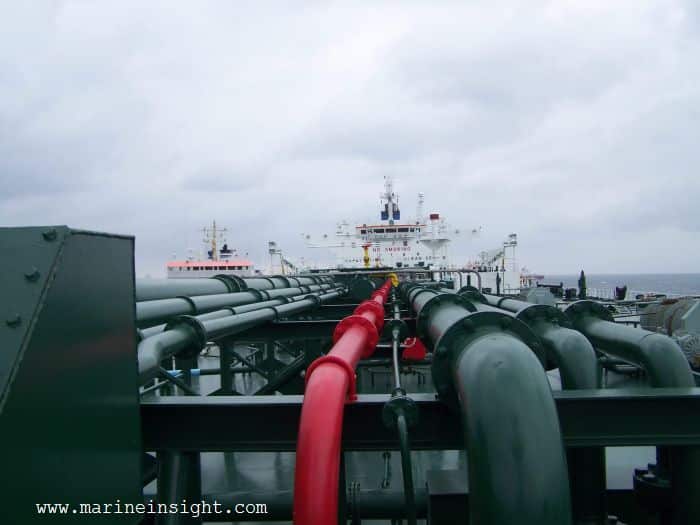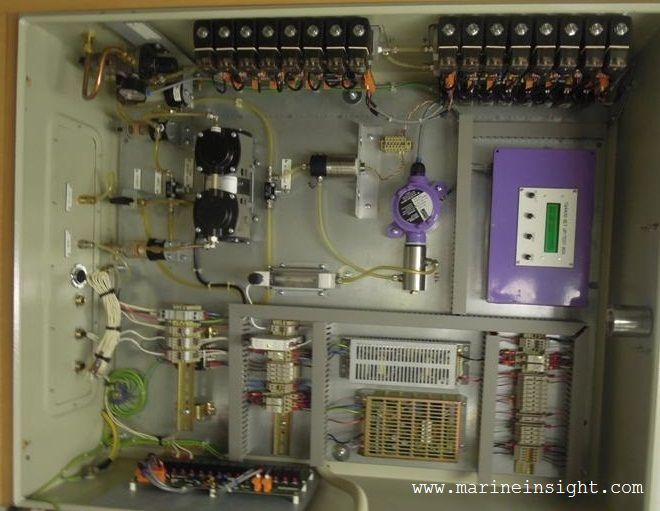

In November 2012, 5 officers on board an LPG tanker died when they “disassembled” a spectacle blind (also called spectacle flange or figure-8 blind used to prevent or start gas flow in a pipe system) without shutting off the inert gas supply, leading to their asphyxiation.
The investigation report said that six officers on board the LPG carrier fainted in the compressor room because of failure to shut off the inert gas supply and to ensure there was no inert gas in the pipe while removing the spectacle blind, leading to the release of inert gas into the compressor room causing asphyxiation.
Inert gas (IG) system is an integral part of cargo operations on tanker ships which must be handled with utmost care considering the hazardous effects of the inert gas on humans.
Officers handling the IG system must consider certain precautions to ensure their safety onboard ships.


Safety devices on IG systems are used to prevent the backflow of cargo gases to the machinery spaces. It is important that along with the non-return valve, a water seal and a vent is also fitted on the deck main for additional safety.
Sometimes an additional water seal is fitted at the bottom of the scrubber. It is important that these devices are properly maintained at all times.
Oxygen deficiency is extremely hazardous to the human body. It can not only damage the brain but can also lead to death easily.
In case of oxygen deficiency, the mind is likely to become apathetic and complacent and if escape is attempted at this stage, physical exertion will aggravate the weakness of the mind and body.
For this reason, it is necessary to ventilate the cargo tanks thoroughly to ensure that no pockets of oxygen deficiency remain and a steady reading of 21% is obtained at all times.
An important point to note is that the inert gas does not affect the toxicity of hydrocarbon gases and thus the latter can be extremely dangerous (as it is flammable).
Gas freeing of tanks must be properly carried out to eliminate possible gas pockets. Any particular compartment must show a reading of Zero or 1% of the lower flammable limit (LFL) with a reliable combustible gas indicator.
An approved combustible gas indicator should be used to measure the presence of flue gases in the tank. Flue gases contain sulphur dioxide, carbon monoxide and nitrogen which need to be properly measured during the gas freeing process.
After ventilation, the flue gas reading of the tank should be 1% or lower than the LFL along with an oxygen reading of 21%. Ventilation should be continued until a steady reading of 21% oxygen is obtained before entering.


Check the tanker pressure before opening any tank lids, ullage plugs or tank washing openings. Inerted cargo tank pressure must be adequately reduced before opening any tank.
In the event of an inert gas system failing to deliver the required quality and quantity of inert gas, or is not able to maintain a positive pressure in the cargo tanks, action must be taken immediately to prevent air from being drawn into the tanks.
All cargo and ballast discharge from inerted tanks must be stopped, the inert gas deck isolating valve closed, the vent valve between it and the gas pressure regulating valve (if provided) opened, and other immediate actions must be taken to repair the inert gas system.
The presence of hydrocarbons in the tanks can be dangerous. If the tank atmosphere contains flue gas, which has small particulate matter containing a small electrostatic charge, there is a possibility of an electrostatic ignition when the oxygen content of the tank rises due to the ingress of air.
Prevent any kind of ingress of air in the tanks.
As Inert gas is asphyxiating, a person can quickly become unconscious even if the leakage of the gas has taken in the open air.
Extra precaution is thus required while doing any maintenance/repair work on the IG plant.
It is recommended that the I.G plant is completely gas freed before any work is started. Internal examination of any unit in the I.G. system should be done only after standard procedures for entry into enclosed spaces have been carried out.
When the oxygen content is reduced during the operation of the I.G. system, pyrophoric deposits are formed in the tankers, especially in those carrying sour crude oil.
These deposits along with crude form hydrogen sulphide, which is highly toxic in nature. Pyrophors and hydrogen sulphide formed during a loaded passage can persist even during subsequent ballast passages if they are not properly removed.
Generally on oil tankers, blowers are used for gas freeing and hence an air inlet (suction from the atmosphere) at the suction side of the blower with blanking arrangement must be provided.
At normal operation, blanking arrangement is to be secured. During gas freeing, it is to be opened and the air is to be supplied by the blower to the tanks.
Learn more about inerting and cargo operations in our ebooks.
1. The Ultimate Guide to Cargo Operation Equipment for Tankers
2. The Ultimate Guide to Cargo Operations for Tankers
Do you know any other important points to consider while handling inert gas on ships?
Disclaimer: The authors’ views expressed in this article do not necessarily reflect the views of The Marine Learners. Data and charts, if used, in the article have been sourced from available information and have not been authenticated by any statutory authority. The author and The Marine Learners do not claim it to be accurate nor accept any responsibility for the same. The views constitute only the opinions and do not constitute any guidelines or recommendations on any course of action to be followed by the reader.










We believe that knowledge is power, and we’re committed to empowering our readers with the information and resources they need to succeed in the merchant navy industry.
Whether you’re looking for advice on career planning, news and analysis, or just want to connect with other aspiring merchant navy applicants, The Marine Learners is the place to be.